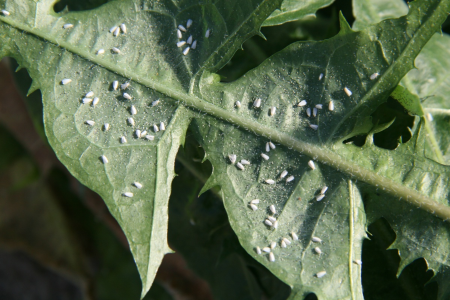Whitefly

Whiteflies feed on a variety of vegetable and floral crops including poinsettias, geraniums, saliva, hibiscus, coleus, tomatoes, lettuce and others. Adult whiteflies are about 1/16” long with snow white wings and a yellow body. Whiteflies can complete their life cycle in 21-36 days depending on the temperatures. Damage from whiteflies is two-fold, they suck the juices out of the host leaves causing wilting and lack of vigor and they also excrete honeydew on which a fungus called sooty mold develops. This sooty mold covers the surface of the leaves and interferes with the plants photosynthetic processes. The easiest way to spot whiteflies is to brush up against plants and see the adults fly. Control can be difficult with the species in some areas becoming resistant to chemicals. There are several control measures that can be used including sticky traps, using a small handheld vacuum to suck up the adults and reduce the population (This is best done in the morning when they are cool and slow moving. You should freeze the vacuum bag for approximately 24 hours to kill the insects vacuumed up.) and chemical controls. If chemical control is warranted alternate the chemicals used as some adults may be resistant to one chemical but not others. Options for control include neem oil, insecticidal soap, horticultural oil, pyrethrin products, imidacloprid, malathion, or permethrin. Be sure to read the labels and make sure the products are listed for house plants and to control whitefly. The best control will be achieved with four or five applications at five to seven-day intervals. Be sure to spray the lower leaf surface and apply as soon as whiteflies are detected rather than waiting till populations become severe. If plants are heavily infested it’s probably best to discard the plants and start over.

https://www.kansas4-h.org/events-activities/contests/photography-judging.html